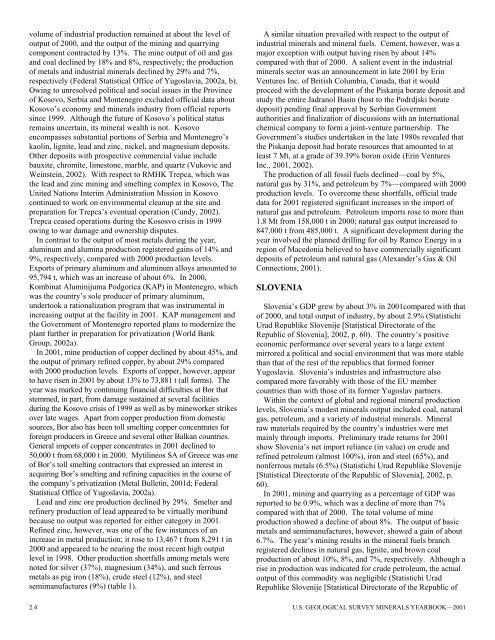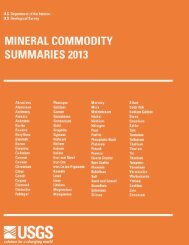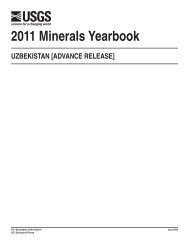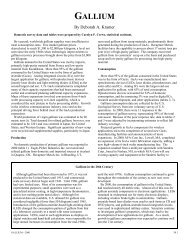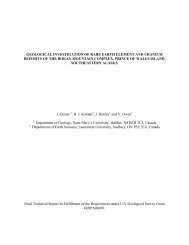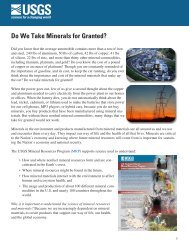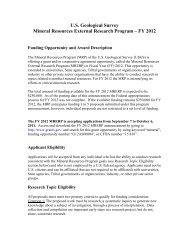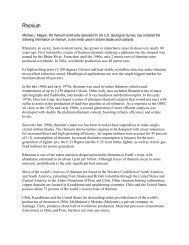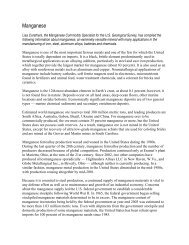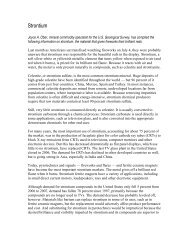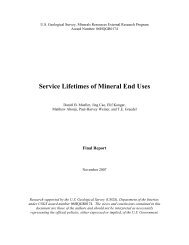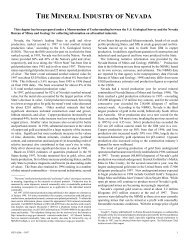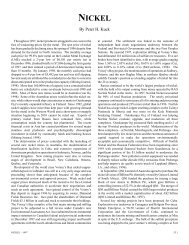the adriatic balkans albania, bosnia and herzegovina, croatia ...
the adriatic balkans albania, bosnia and herzegovina, croatia ...
the adriatic balkans albania, bosnia and herzegovina, croatia ...
You also want an ePaper? Increase the reach of your titles
YUMPU automatically turns print PDFs into web optimized ePapers that Google loves.
volume of industrial production remained at about <strong>the</strong> level of<br />
output of 2000, <strong>and</strong> <strong>the</strong> output of <strong>the</strong> mining <strong>and</strong> quarrying<br />
component contracted by 13%. The mine output of oil <strong>and</strong> gas<br />
<strong>and</strong> coal declined by 18% <strong>and</strong> 8%, respectively; <strong>the</strong> production<br />
of metals <strong>and</strong> industrial minerals declined by 29% <strong>and</strong> 7%,<br />
respectively (Federal Statistical Office of Yugoslavia, 2002a, b).<br />
Owing to unresolved political <strong>and</strong> social issues in <strong>the</strong> Province<br />
of Kosovo, Serbia <strong>and</strong> Montenegro excluded official data about<br />
Kosovo’s economy <strong>and</strong> minerals industry from official reports<br />
since 1999. Although <strong>the</strong> future of Kosovo’s political status<br />
remains uncertain, its mineral wealth is not. Kosovo<br />
encompasses substantial portions of Serbia <strong>and</strong> Montenegro’s<br />
kaolin, lignite, lead <strong>and</strong> zinc, nickel, <strong>and</strong> magnesium deposits.<br />
O<strong>the</strong>r deposits with prospective commercial value include<br />
bauxite, chromite, limestone, marble, <strong>and</strong> quartz (Vukovic <strong>and</strong><br />
Weinstein, 2002). With respect to RMHK Trepca, which was<br />
<strong>the</strong> lead <strong>and</strong> zinc mining <strong>and</strong> smelting complex in Kosovo, The<br />
United Nations Interim Administration Mission in Kosovo<br />
continued to work on environmental cleanup at <strong>the</strong> site <strong>and</strong><br />
preparation for Trepca’s eventual operation (Cundy, 2002).<br />
Trepca ceased operations during <strong>the</strong> Kososvo crisis in 1999<br />
owing to war damage <strong>and</strong> ownership disputes.<br />
In contrast to <strong>the</strong> output of most metals during <strong>the</strong> year,<br />
aluminum <strong>and</strong> alumina production registered gains of 14% <strong>and</strong><br />
9%, respectively, compared with 2000 production levels.<br />
Exports of primary aluminum <strong>and</strong> aluminum alloys amounted to<br />
95,794 t, which was an increase of about 6%. In 2000,<br />
Kombinat Aluminijuma Podgorica (KAP) in Montenegro, which<br />
was <strong>the</strong> country’s sole producer of primary aluminum,<br />
undertook a rationalization program that was instrumental in<br />
increasing output at <strong>the</strong> facility in 2001. KAP management <strong>and</strong><br />
<strong>the</strong> Government of Montenegro reported plans to modernize <strong>the</strong><br />
plant fur<strong>the</strong>r in preparation for privatization (World Bank<br />
Group, 2002a).<br />
In 2001, mine production of copper declined by about 45%, <strong>and</strong><br />
<strong>the</strong> output of primary refined copper, by about 29% compared<br />
with 2000 production levels. Exports of copper, however, appear<br />
to have risen in 2001 by about 13% to 73,881 t (all forms). The<br />
year was marked by continuing financial difficulties at Bor that<br />
stemmed, in part, from damage sustained at several facilities<br />
during <strong>the</strong> Kosovo crisis of 1999 as well as by mineworker strikes<br />
over late wages. Apart from copper production from domestic<br />
sources, Bor also has been toll smelting copper concentrates for<br />
foreign producers in Greece <strong>and</strong> several o<strong>the</strong>r Balkan countries.<br />
General imports of copper concentrates in 2001 declined to<br />
50,000 t from 68,000 t in 2000. Mytilineos SA of Greece was one<br />
of Bor’s toll smelting contractors that expressed an interest in<br />
acquiring Bor’s smelting <strong>and</strong> refining capacities in <strong>the</strong> course of<br />
<strong>the</strong> company’s privatization (Metal Bulletin, 2001d; Federal<br />
Statistical Office of Yugoslavia, 2002a).<br />
Lead <strong>and</strong> zinc ore production declined by 29%. Smelter <strong>and</strong><br />
refinery production of lead appeared to be virtually moribund<br />
because no output was reported for ei<strong>the</strong>r category in 2001.<br />
Refined zinc, however, was one of <strong>the</strong> few instances of an<br />
increase in metal production; it rose to 13,467 t from 8,291 t in<br />
2000 <strong>and</strong> appeared to be nearing <strong>the</strong> most recent high output<br />
level in 1998. O<strong>the</strong>r production shortfalls among metals were<br />
noted for silver (37%), magnesium (34%), <strong>and</strong> such ferrous<br />
metals as pig iron (18%), crude steel (12%), <strong>and</strong> steel<br />
semimanufactures (9%) (table 1).<br />
2.4<br />
A similar situation prevailed with respect to <strong>the</strong> output of<br />
industrial minerals <strong>and</strong> mineral fuels. Cement, however, was a<br />
major exception with output having risen by about 14%<br />
compared with that of 2000. A salient event in <strong>the</strong> industrial<br />
minerals sector was an announcement in late 2001 by Erin<br />
Ventures Inc. of British Columbia, Canada, that it would<br />
proceed with <strong>the</strong> development of <strong>the</strong> Piskanja borate deposit <strong>and</strong><br />
study <strong>the</strong> entire Jadranol Basin (host to <strong>the</strong> Podrdjski borate<br />
deposit) pending final approval by Serbian Government<br />
authorities <strong>and</strong> finalization of discussions with an international<br />
chemical company to form a joint-venture partnership. The<br />
Government’s studies undertaken in <strong>the</strong> late 1980s revealed that<br />
<strong>the</strong> Piskanja deposit had borate resources that amounted to at<br />
least 7 Mt, at a grade of 39.39% boron oxide (Erin Ventures<br />
Inc., 2001, 2002).<br />
The production of all fossil fuels declined—coal by 5%,<br />
natural gas by 31%, <strong>and</strong> petroleum by 7%—compared with 2000<br />
production levels. To overcome <strong>the</strong>se shortfalls, official trade<br />
data for 2001 registered significant increases in <strong>the</strong> import of<br />
natural gas <strong>and</strong> petroleum. Petroleum imports rose to more than<br />
1.8 Mt from 158,000 t in 2000; natural gas output increased to<br />
847,000 t from 485,000 t. A significant development during <strong>the</strong><br />
year involved <strong>the</strong> planned drilling for oil by Ramco Energy in a<br />
region of Macedonia believed to have commercially significant<br />
deposits of petroleum <strong>and</strong> natural gas (Alex<strong>and</strong>er’s Gas & Oil<br />
Connections, 2001).<br />
SLOVENIA<br />
Slovenia’s GDP grew by about 3% in 2001compared with that<br />
of 2000, <strong>and</strong> total output of industry, by about 2.9% (Statistichi<br />
Urad Republike Slovenije [Statistical Directorate of <strong>the</strong><br />
Republic of Slovenia], 2002, p. 60). The country’s positive<br />
economic performance over several years to a large extent<br />
mirrored a political <strong>and</strong> social environment that was more stable<br />
than that of <strong>the</strong> rest of <strong>the</strong> republics that formed former<br />
Yugoslavia. Slovenia’s industries <strong>and</strong> infrastructure also<br />
compared more favorably with those of <strong>the</strong> EU member<br />
countries than with those of its former Yugoslav partners.<br />
Within <strong>the</strong> context of global <strong>and</strong> regional mineral production<br />
levels, Slovenia’s modest minerals output included coal, natural<br />
gas, petroleum, <strong>and</strong> a variety of industrial minerals. Mineral<br />
raw materials required by <strong>the</strong> country’s industries were met<br />
mainly through imports. Preliminary trade returns for 2001<br />
show Slovenia’s net import reliance (in value) on crude <strong>and</strong><br />
refined petroleum (almost 100%), iron <strong>and</strong> steel (65%), <strong>and</strong><br />
nonferrous metals (6.5%) (Statistichi Urad Republike Slovenije<br />
[Statistical Directorate of <strong>the</strong> Republic of Slovenia], 2002, p.<br />
60).<br />
In 2001, mining <strong>and</strong> quarrying as a percentage of GDP was<br />
reported to be 0.9%, which was a decline of more than 7%<br />
compared with that of 2000. The total volume of mine<br />
production showed a decline of about 8%. The output of basic<br />
metals <strong>and</strong> semimanufactures, however, showed a gain of about<br />
6.7%. The year’s mining results in <strong>the</strong> mineral fuels branch<br />
registered declines in natural gas, lignite, <strong>and</strong> brown coal<br />
production of about 10%, 8%, <strong>and</strong> 7%, respectively. Although a<br />
rise in production was indicated for crude petroleum, <strong>the</strong> actual<br />
output of this commodity was negligible (Statistichi Urad<br />
Republike Slovenije [Statistical Directorate of <strong>the</strong> Republic of<br />
U.S. GEOLOGICAL SURVEY MINERALS YEARBOOK—2001


